Talent Management Strategies: Leaders & Employee Retention at H&M
VerifiedAdded on 2023/06/07
|38
|6331
|179
Report
AI Summary
This research report investigates the importance of talent management strategies used by line managers and leaders in H&M to develop and retain employees. It explores the concept and need for talent management, examines specific strategies adopted by line managers and leaders, and analyzes their roles and responsibilities in relation to employees. The study employs a quantitative research methodology, utilizing statistical data to understand the impact of these strategies on employee retention and overall organizational performance. The literature review covers understanding talent management, identifying retention strategies, and investigating the roles of line managers. The report concludes with recommendations for H&M and implications for future research, emphasizing the significance of effective talent management in maintaining a productive and engaged workforce.
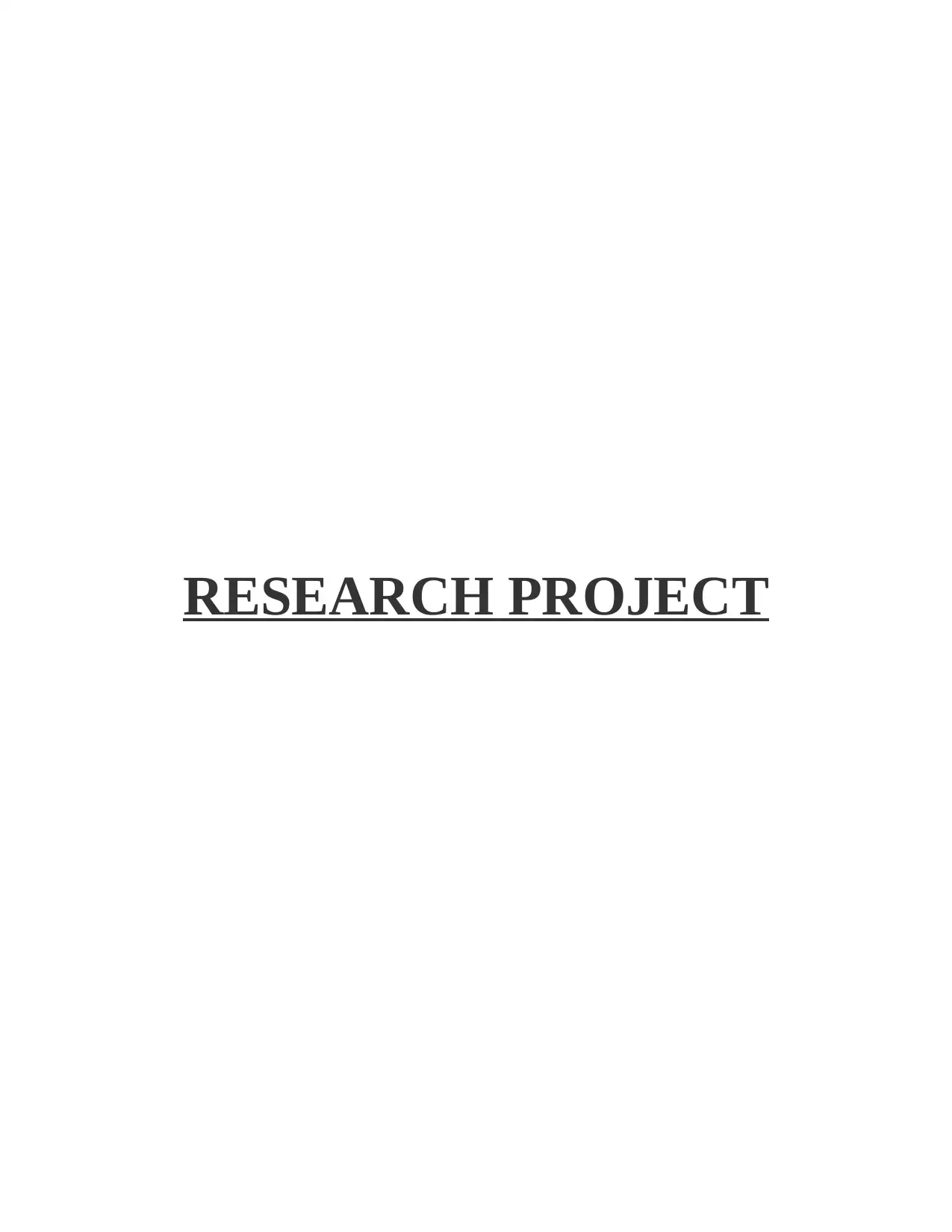
RESEARCH PROJECT
Paraphrase This Document
Need a fresh take? Get an instant paraphrase of this document with our AI Paraphraser
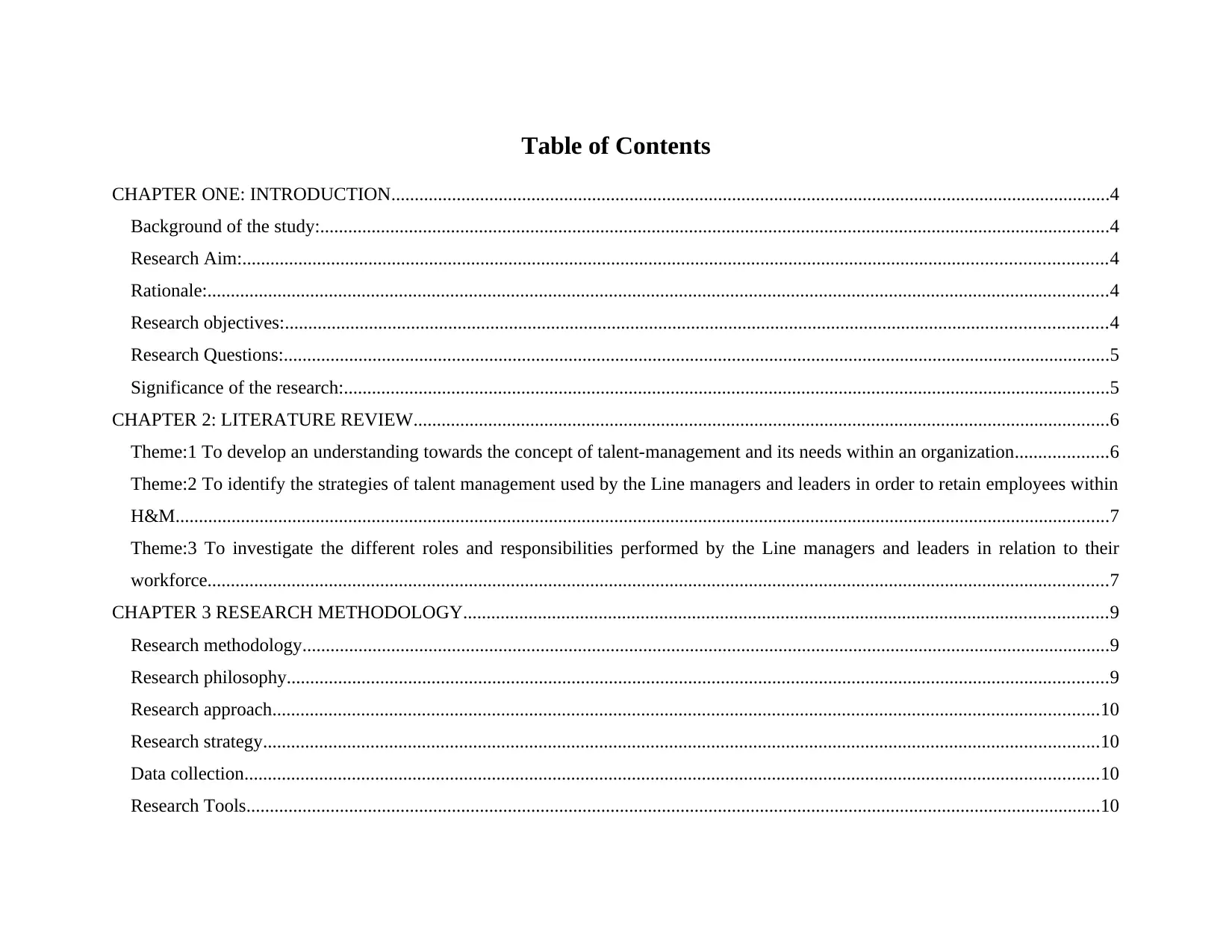
Table of Contents
CHAPTER ONE: INTRODUCTION..........................................................................................................................................................4
Background of the study:.........................................................................................................................................................................4
Research Aim:.........................................................................................................................................................................................4
Rationale:.................................................................................................................................................................................................4
Research objectives:................................................................................................................................................................................4
Research Questions:.................................................................................................................................................................................5
Significance of the research:....................................................................................................................................................................5
CHAPTER 2: LITERATURE REVIEW.....................................................................................................................................................6
Theme:1 To develop an understanding towards the concept of talent-management and its needs within an organization....................6
Theme:2 To identify the strategies of talent management used by the Line managers and leaders in order to retain employees within
H&M........................................................................................................................................................................................................7
Theme:3 To investigate the different roles and responsibilities performed by the Line managers and leaders in relation to their
workforce.................................................................................................................................................................................................7
CHAPTER 3 RESEARCH METHODOLOGY..........................................................................................................................................9
Research methodology.............................................................................................................................................................................9
Research philosophy................................................................................................................................................................................9
Research approach.................................................................................................................................................................................10
Research strategy...................................................................................................................................................................................10
Data collection.......................................................................................................................................................................................10
Research Tools.......................................................................................................................................................................................10
CHAPTER ONE: INTRODUCTION..........................................................................................................................................................4
Background of the study:.........................................................................................................................................................................4
Research Aim:.........................................................................................................................................................................................4
Rationale:.................................................................................................................................................................................................4
Research objectives:................................................................................................................................................................................4
Research Questions:.................................................................................................................................................................................5
Significance of the research:....................................................................................................................................................................5
CHAPTER 2: LITERATURE REVIEW.....................................................................................................................................................6
Theme:1 To develop an understanding towards the concept of talent-management and its needs within an organization....................6
Theme:2 To identify the strategies of talent management used by the Line managers and leaders in order to retain employees within
H&M........................................................................................................................................................................................................7
Theme:3 To investigate the different roles and responsibilities performed by the Line managers and leaders in relation to their
workforce.................................................................................................................................................................................................7
CHAPTER 3 RESEARCH METHODOLOGY..........................................................................................................................................9
Research methodology.............................................................................................................................................................................9
Research philosophy................................................................................................................................................................................9
Research approach.................................................................................................................................................................................10
Research strategy...................................................................................................................................................................................10
Data collection.......................................................................................................................................................................................10
Research Tools.......................................................................................................................................................................................10
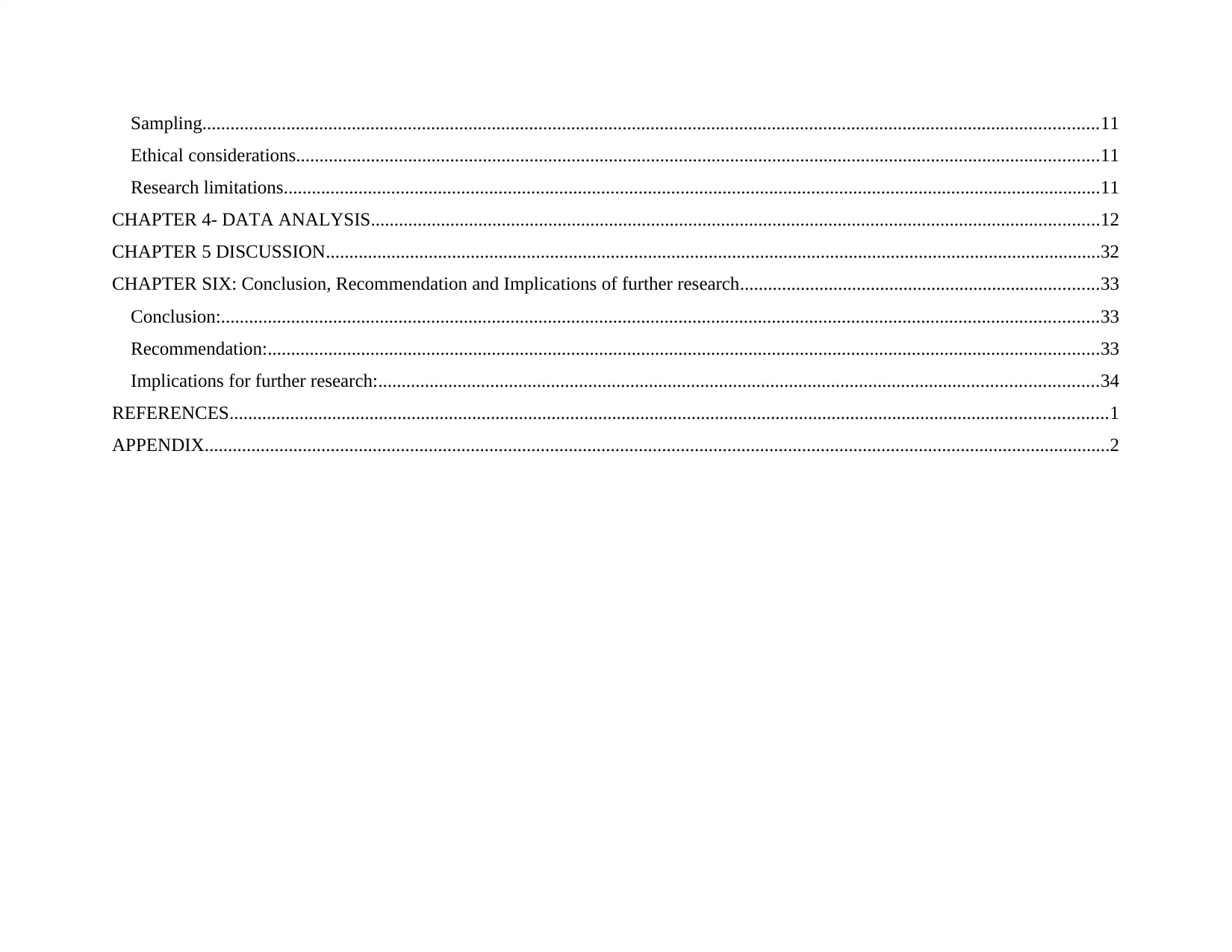
Sampling................................................................................................................................................................................................11
Ethical considerations............................................................................................................................................................................11
Research limitations...............................................................................................................................................................................11
CHAPTER 4- DATA ANALYSIS............................................................................................................................................................12
CHAPTER 5 DISCUSSION......................................................................................................................................................................32
CHAPTER SIX: Conclusion, Recommendation and Implications of further research.............................................................................33
Conclusion:............................................................................................................................................................................................33
Recommendation:..................................................................................................................................................................................33
Implications for further research:..........................................................................................................................................................34
REFERENCES............................................................................................................................................................................................1
APPENDIX..................................................................................................................................................................................................2
Ethical considerations............................................................................................................................................................................11
Research limitations...............................................................................................................................................................................11
CHAPTER 4- DATA ANALYSIS............................................................................................................................................................12
CHAPTER 5 DISCUSSION......................................................................................................................................................................32
CHAPTER SIX: Conclusion, Recommendation and Implications of further research.............................................................................33
Conclusion:............................................................................................................................................................................................33
Recommendation:..................................................................................................................................................................................33
Implications for further research:..........................................................................................................................................................34
REFERENCES............................................................................................................................................................................................1
APPENDIX..................................................................................................................................................................................................2
⊘ This is a preview!⊘
Do you want full access?
Subscribe today to unlock all pages.

Trusted by 1+ million students worldwide
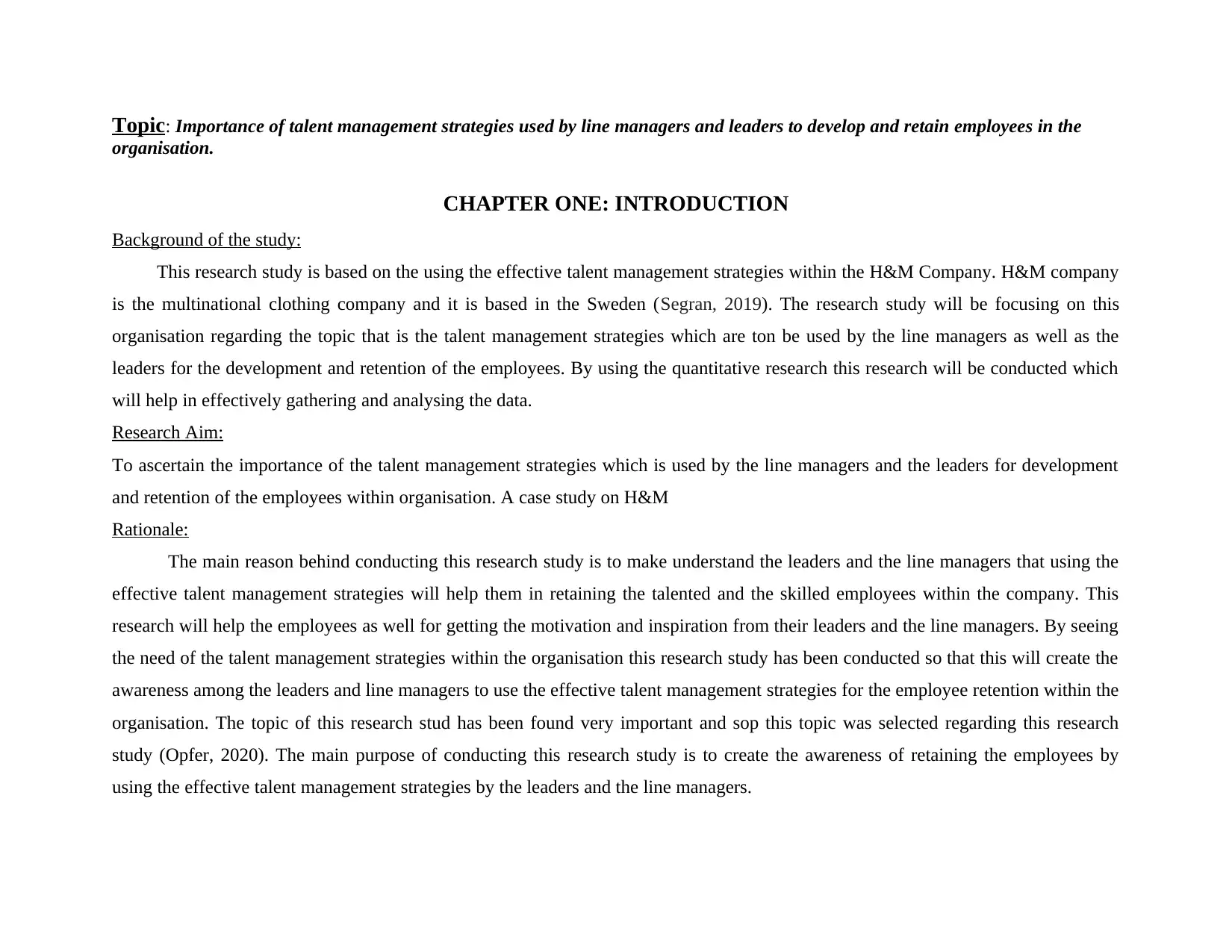
Topic: Importance of talent management strategies used by line managers and leaders to develop and retain employees in the
organisation.
CHAPTER ONE: INTRODUCTION
Background of the study:
This research study is based on the using the effective talent management strategies within the H&M Company. H&M company
is the multinational clothing company and it is based in the Sweden (Segran, 2019). The research study will be focusing on this
organisation regarding the topic that is the talent management strategies which are ton be used by the line managers as well as the
leaders for the development and retention of the employees. By using the quantitative research this research will be conducted which
will help in effectively gathering and analysing the data.
Research Aim:
To ascertain the importance of the talent management strategies which is used by the line managers and the leaders for development
and retention of the employees within organisation. A case study on H&M
Rationale:
The main reason behind conducting this research study is to make understand the leaders and the line managers that using the
effective talent management strategies will help them in retaining the talented and the skilled employees within the company. This
research will help the employees as well for getting the motivation and inspiration from their leaders and the line managers. By seeing
the need of the talent management strategies within the organisation this research study has been conducted so that this will create the
awareness among the leaders and line managers to use the effective talent management strategies for the employee retention within the
organisation. The topic of this research stud has been found very important and sop this topic was selected regarding this research
study (Opfer, 2020). The main purpose of conducting this research study is to create the awareness of retaining the employees by
using the effective talent management strategies by the leaders and the line managers.
organisation.
CHAPTER ONE: INTRODUCTION
Background of the study:
This research study is based on the using the effective talent management strategies within the H&M Company. H&M company
is the multinational clothing company and it is based in the Sweden (Segran, 2019). The research study will be focusing on this
organisation regarding the topic that is the talent management strategies which are ton be used by the line managers as well as the
leaders for the development and retention of the employees. By using the quantitative research this research will be conducted which
will help in effectively gathering and analysing the data.
Research Aim:
To ascertain the importance of the talent management strategies which is used by the line managers and the leaders for development
and retention of the employees within organisation. A case study on H&M
Rationale:
The main reason behind conducting this research study is to make understand the leaders and the line managers that using the
effective talent management strategies will help them in retaining the talented and the skilled employees within the company. This
research will help the employees as well for getting the motivation and inspiration from their leaders and the line managers. By seeing
the need of the talent management strategies within the organisation this research study has been conducted so that this will create the
awareness among the leaders and line managers to use the effective talent management strategies for the employee retention within the
organisation. The topic of this research stud has been found very important and sop this topic was selected regarding this research
study (Opfer, 2020). The main purpose of conducting this research study is to create the awareness of retaining the employees by
using the effective talent management strategies by the leaders and the line managers.
Paraphrase This Document
Need a fresh take? Get an instant paraphrase of this document with our AI Paraphraser
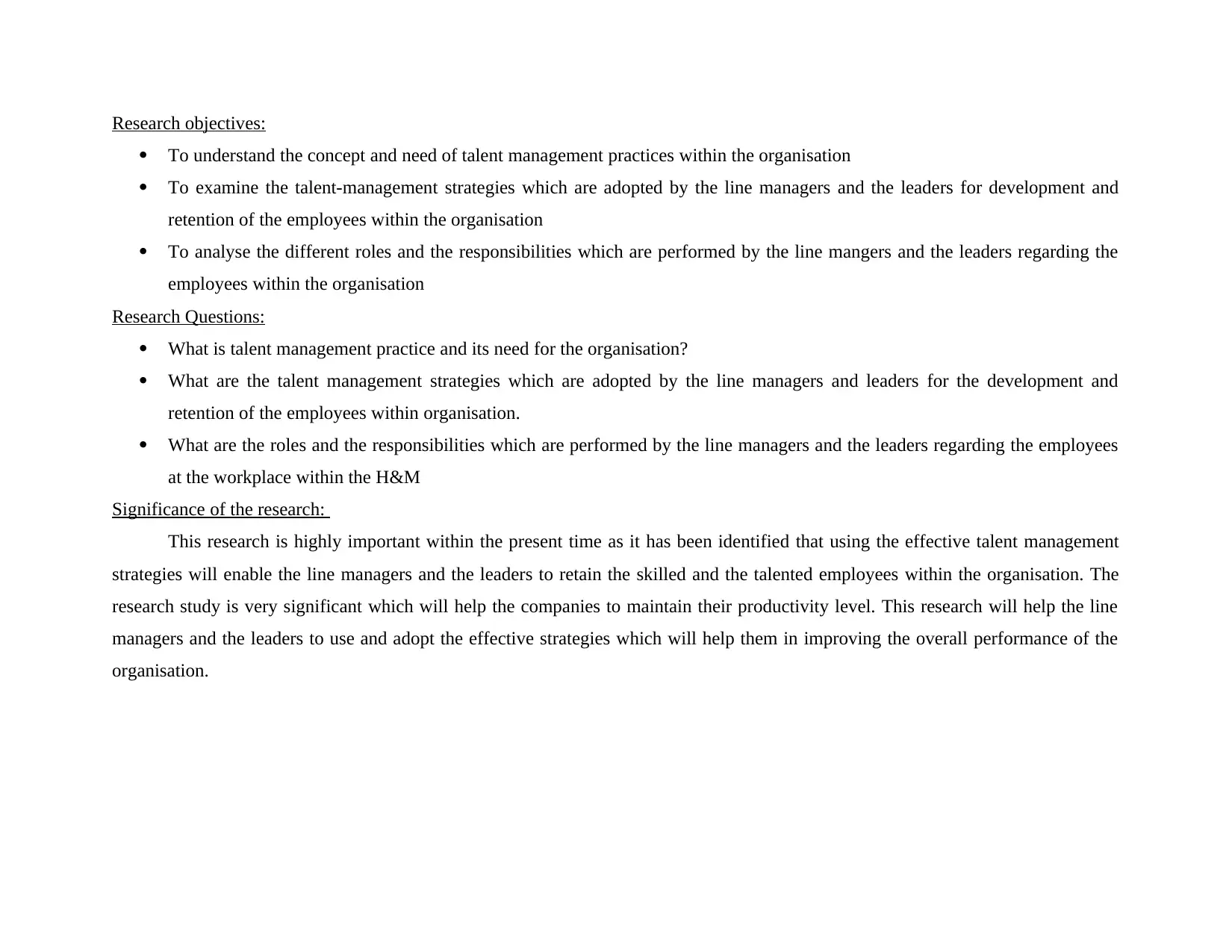
Research objectives:
To understand the concept and need of talent management practices within the organisation
To examine the talent-management strategies which are adopted by the line managers and the leaders for development and
retention of the employees within the organisation
To analyse the different roles and the responsibilities which are performed by the line mangers and the leaders regarding the
employees within the organisation
Research Questions:
What is talent management practice and its need for the organisation?
What are the talent management strategies which are adopted by the line managers and leaders for the development and
retention of the employees within organisation.
What are the roles and the responsibilities which are performed by the line managers and the leaders regarding the employees
at the workplace within the H&M
Significance of the research:
This research is highly important within the present time as it has been identified that using the effective talent management
strategies will enable the line managers and the leaders to retain the skilled and the talented employees within the organisation. The
research study is very significant which will help the companies to maintain their productivity level. This research will help the line
managers and the leaders to use and adopt the effective strategies which will help them in improving the overall performance of the
organisation.
To understand the concept and need of talent management practices within the organisation
To examine the talent-management strategies which are adopted by the line managers and the leaders for development and
retention of the employees within the organisation
To analyse the different roles and the responsibilities which are performed by the line mangers and the leaders regarding the
employees within the organisation
Research Questions:
What is talent management practice and its need for the organisation?
What are the talent management strategies which are adopted by the line managers and leaders for the development and
retention of the employees within organisation.
What are the roles and the responsibilities which are performed by the line managers and the leaders regarding the employees
at the workplace within the H&M
Significance of the research:
This research is highly important within the present time as it has been identified that using the effective talent management
strategies will enable the line managers and the leaders to retain the skilled and the talented employees within the organisation. The
research study is very significant which will help the companies to maintain their productivity level. This research will help the line
managers and the leaders to use and adopt the effective strategies which will help them in improving the overall performance of the
organisation.
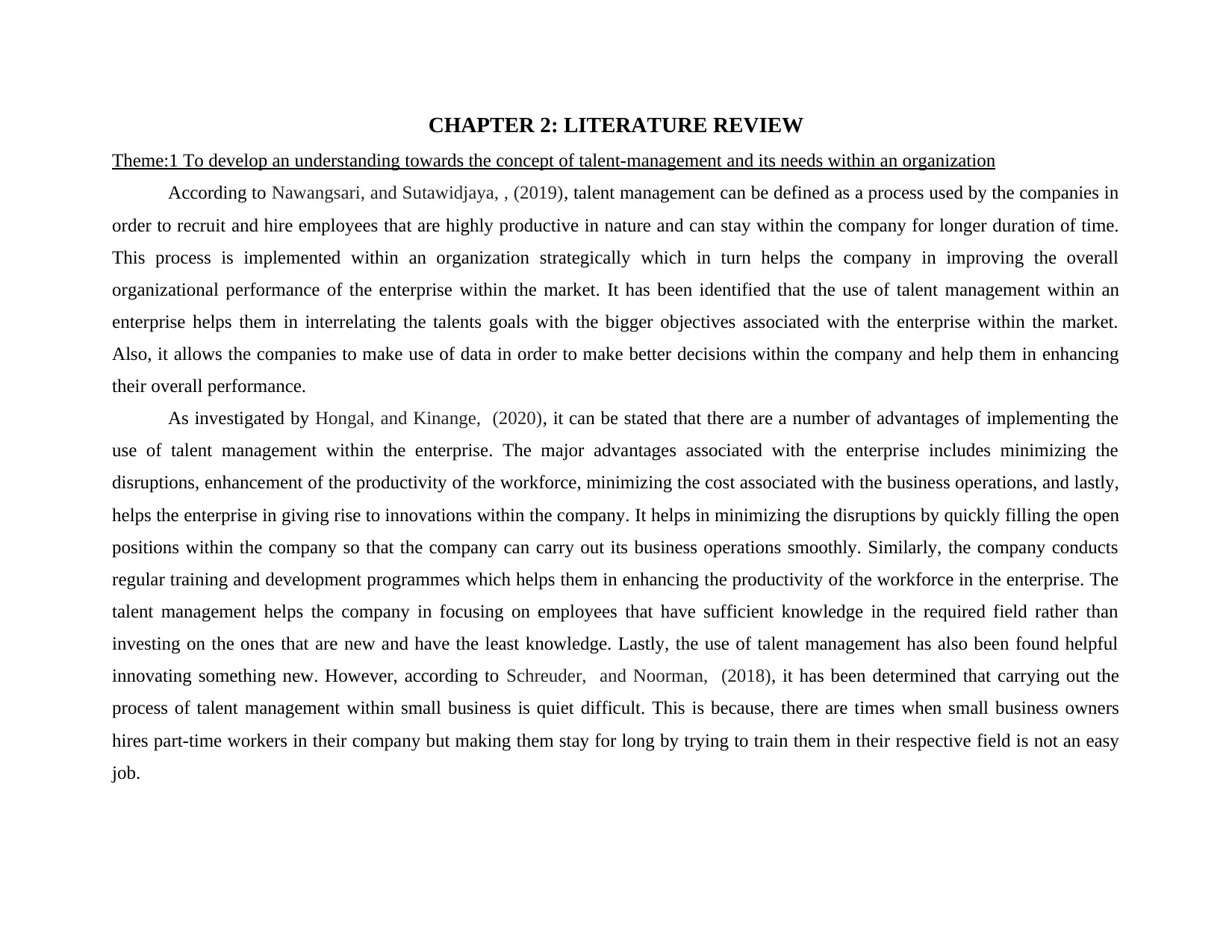
CHAPTER 2: LITERATURE REVIEW
Theme:1 To develop an understanding towards the concept of talent-management and its needs within an organization
According to Nawangsari, and Sutawidjaya, , (2019), talent management can be defined as a process used by the companies in
order to recruit and hire employees that are highly productive in nature and can stay within the company for longer duration of time.
This process is implemented within an organization strategically which in turn helps the company in improving the overall
organizational performance of the enterprise within the market. It has been identified that the use of talent management within an
enterprise helps them in interrelating the talents goals with the bigger objectives associated with the enterprise within the market.
Also, it allows the companies to make use of data in order to make better decisions within the company and help them in enhancing
their overall performance.
As investigated by Hongal, and Kinange, (2020), it can be stated that there are a number of advantages of implementing the
use of talent management within the enterprise. The major advantages associated with the enterprise includes minimizing the
disruptions, enhancement of the productivity of the workforce, minimizing the cost associated with the business operations, and lastly,
helps the enterprise in giving rise to innovations within the company. It helps in minimizing the disruptions by quickly filling the open
positions within the company so that the company can carry out its business operations smoothly. Similarly, the company conducts
regular training and development programmes which helps them in enhancing the productivity of the workforce in the enterprise. The
talent management helps the company in focusing on employees that have sufficient knowledge in the required field rather than
investing on the ones that are new and have the least knowledge. Lastly, the use of talent management has also been found helpful
innovating something new. However, according to Schreuder, and Noorman, (2018), it has been determined that carrying out the
process of talent management within small business is quiet difficult. This is because, there are times when small business owners
hires part-time workers in their company but making them stay for long by trying to train them in their respective field is not an easy
job.
Theme:1 To develop an understanding towards the concept of talent-management and its needs within an organization
According to Nawangsari, and Sutawidjaya, , (2019), talent management can be defined as a process used by the companies in
order to recruit and hire employees that are highly productive in nature and can stay within the company for longer duration of time.
This process is implemented within an organization strategically which in turn helps the company in improving the overall
organizational performance of the enterprise within the market. It has been identified that the use of talent management within an
enterprise helps them in interrelating the talents goals with the bigger objectives associated with the enterprise within the market.
Also, it allows the companies to make use of data in order to make better decisions within the company and help them in enhancing
their overall performance.
As investigated by Hongal, and Kinange, (2020), it can be stated that there are a number of advantages of implementing the
use of talent management within the enterprise. The major advantages associated with the enterprise includes minimizing the
disruptions, enhancement of the productivity of the workforce, minimizing the cost associated with the business operations, and lastly,
helps the enterprise in giving rise to innovations within the company. It helps in minimizing the disruptions by quickly filling the open
positions within the company so that the company can carry out its business operations smoothly. Similarly, the company conducts
regular training and development programmes which helps them in enhancing the productivity of the workforce in the enterprise. The
talent management helps the company in focusing on employees that have sufficient knowledge in the required field rather than
investing on the ones that are new and have the least knowledge. Lastly, the use of talent management has also been found helpful
innovating something new. However, according to Schreuder, and Noorman, (2018), it has been determined that carrying out the
process of talent management within small business is quiet difficult. This is because, there are times when small business owners
hires part-time workers in their company but making them stay for long by trying to train them in their respective field is not an easy
job.
⊘ This is a preview!⊘
Do you want full access?
Subscribe today to unlock all pages.

Trusted by 1+ million students worldwide
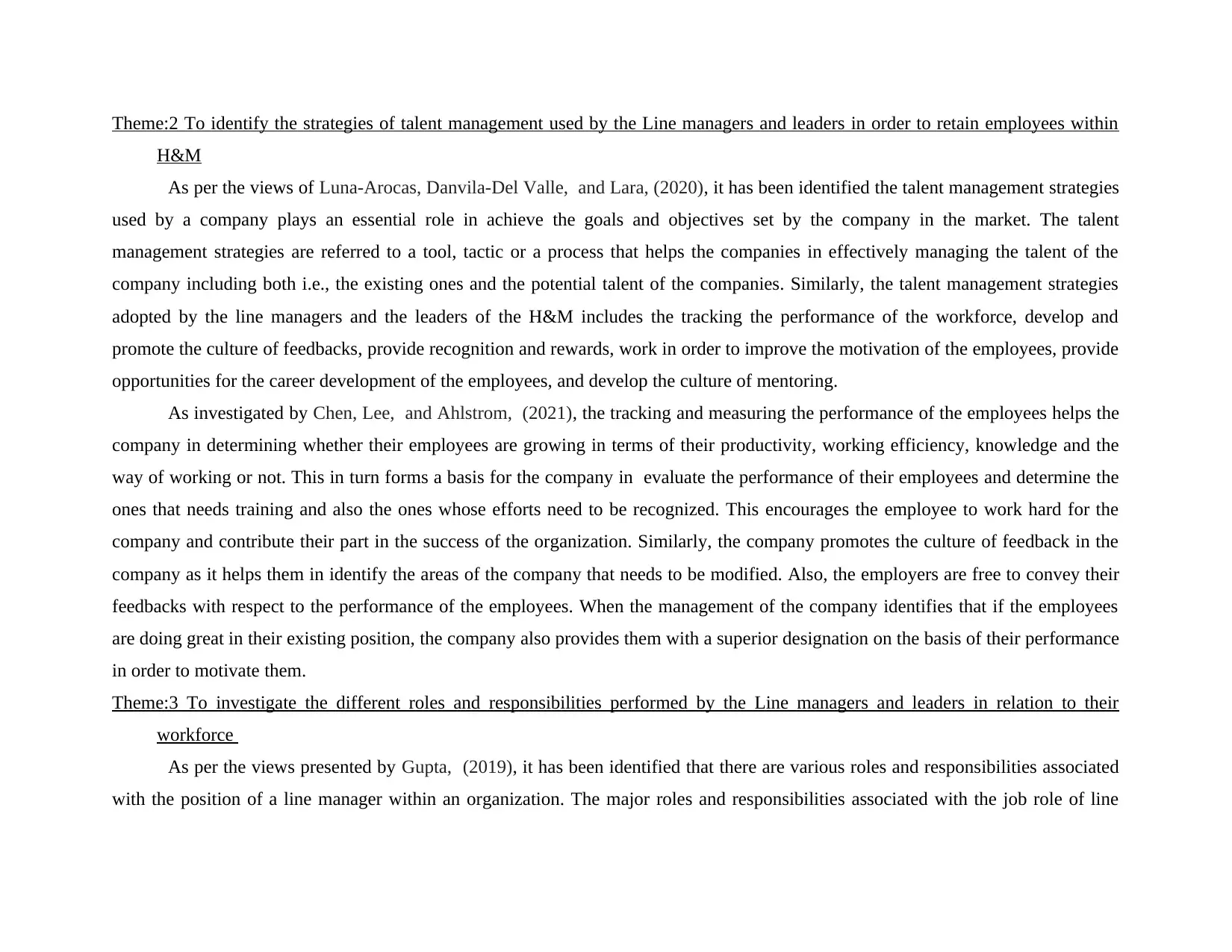
Theme:2 To identify the strategies of talent management used by the Line managers and leaders in order to retain employees within
H&M
As per the views of Luna-Arocas, Danvila-Del Valle, and Lara, (2020), it has been identified the talent management strategies
used by a company plays an essential role in achieve the goals and objectives set by the company in the market. The talent
management strategies are referred to a tool, tactic or a process that helps the companies in effectively managing the talent of the
company including both i.e., the existing ones and the potential talent of the companies. Similarly, the talent management strategies
adopted by the line managers and the leaders of the H&M includes the tracking the performance of the workforce, develop and
promote the culture of feedbacks, provide recognition and rewards, work in order to improve the motivation of the employees, provide
opportunities for the career development of the employees, and develop the culture of mentoring.
As investigated by Chen, Lee, and Ahlstrom, (2021), the tracking and measuring the performance of the employees helps the
company in determining whether their employees are growing in terms of their productivity, working efficiency, knowledge and the
way of working or not. This in turn forms a basis for the company in evaluate the performance of their employees and determine the
ones that needs training and also the ones whose efforts need to be recognized. This encourages the employee to work hard for the
company and contribute their part in the success of the organization. Similarly, the company promotes the culture of feedback in the
company as it helps them in identify the areas of the company that needs to be modified. Also, the employers are free to convey their
feedbacks with respect to the performance of the employees. When the management of the company identifies that if the employees
are doing great in their existing position, the company also provides them with a superior designation on the basis of their performance
in order to motivate them.
Theme:3 To investigate the different roles and responsibilities performed by the Line managers and leaders in relation to their
workforce
As per the views presented by Gupta, (2019), it has been identified that there are various roles and responsibilities associated
with the position of a line manager within an organization. The major roles and responsibilities associated with the job role of line
H&M
As per the views of Luna-Arocas, Danvila-Del Valle, and Lara, (2020), it has been identified the talent management strategies
used by a company plays an essential role in achieve the goals and objectives set by the company in the market. The talent
management strategies are referred to a tool, tactic or a process that helps the companies in effectively managing the talent of the
company including both i.e., the existing ones and the potential talent of the companies. Similarly, the talent management strategies
adopted by the line managers and the leaders of the H&M includes the tracking the performance of the workforce, develop and
promote the culture of feedbacks, provide recognition and rewards, work in order to improve the motivation of the employees, provide
opportunities for the career development of the employees, and develop the culture of mentoring.
As investigated by Chen, Lee, and Ahlstrom, (2021), the tracking and measuring the performance of the employees helps the
company in determining whether their employees are growing in terms of their productivity, working efficiency, knowledge and the
way of working or not. This in turn forms a basis for the company in evaluate the performance of their employees and determine the
ones that needs training and also the ones whose efforts need to be recognized. This encourages the employee to work hard for the
company and contribute their part in the success of the organization. Similarly, the company promotes the culture of feedback in the
company as it helps them in identify the areas of the company that needs to be modified. Also, the employers are free to convey their
feedbacks with respect to the performance of the employees. When the management of the company identifies that if the employees
are doing great in their existing position, the company also provides them with a superior designation on the basis of their performance
in order to motivate them.
Theme:3 To investigate the different roles and responsibilities performed by the Line managers and leaders in relation to their
workforce
As per the views presented by Gupta, (2019), it has been identified that there are various roles and responsibilities associated
with the position of a line manager within an organization. The major roles and responsibilities associated with the job role of line
Paraphrase This Document
Need a fresh take? Get an instant paraphrase of this document with our AI Paraphraser
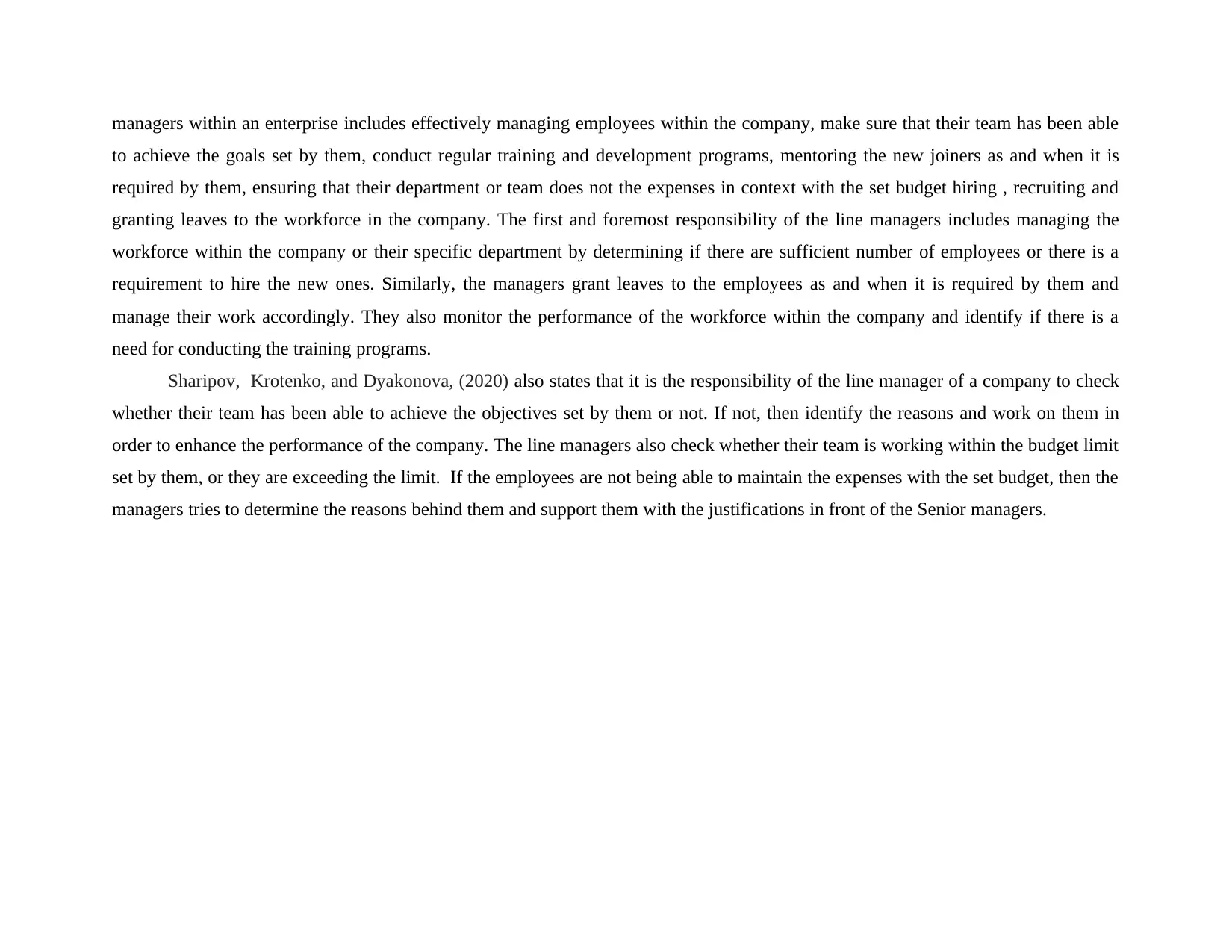
managers within an enterprise includes effectively managing employees within the company, make sure that their team has been able
to achieve the goals set by them, conduct regular training and development programs, mentoring the new joiners as and when it is
required by them, ensuring that their department or team does not the expenses in context with the set budget hiring , recruiting and
granting leaves to the workforce in the company. The first and foremost responsibility of the line managers includes managing the
workforce within the company or their specific department by determining if there are sufficient number of employees or there is a
requirement to hire the new ones. Similarly, the managers grant leaves to the employees as and when it is required by them and
manage their work accordingly. They also monitor the performance of the workforce within the company and identify if there is a
need for conducting the training programs.
Sharipov, Krotenko, and Dyakonova, (2020) also states that it is the responsibility of the line manager of a company to check
whether their team has been able to achieve the objectives set by them or not. If not, then identify the reasons and work on them in
order to enhance the performance of the company. The line managers also check whether their team is working within the budget limit
set by them, or they are exceeding the limit. If the employees are not being able to maintain the expenses with the set budget, then the
managers tries to determine the reasons behind them and support them with the justifications in front of the Senior managers.
to achieve the goals set by them, conduct regular training and development programs, mentoring the new joiners as and when it is
required by them, ensuring that their department or team does not the expenses in context with the set budget hiring , recruiting and
granting leaves to the workforce in the company. The first and foremost responsibility of the line managers includes managing the
workforce within the company or their specific department by determining if there are sufficient number of employees or there is a
requirement to hire the new ones. Similarly, the managers grant leaves to the employees as and when it is required by them and
manage their work accordingly. They also monitor the performance of the workforce within the company and identify if there is a
need for conducting the training programs.
Sharipov, Krotenko, and Dyakonova, (2020) also states that it is the responsibility of the line manager of a company to check
whether their team has been able to achieve the objectives set by them or not. If not, then identify the reasons and work on them in
order to enhance the performance of the company. The line managers also check whether their team is working within the budget limit
set by them, or they are exceeding the limit. If the employees are not being able to maintain the expenses with the set budget, then the
managers tries to determine the reasons behind them and support them with the justifications in front of the Senior managers.
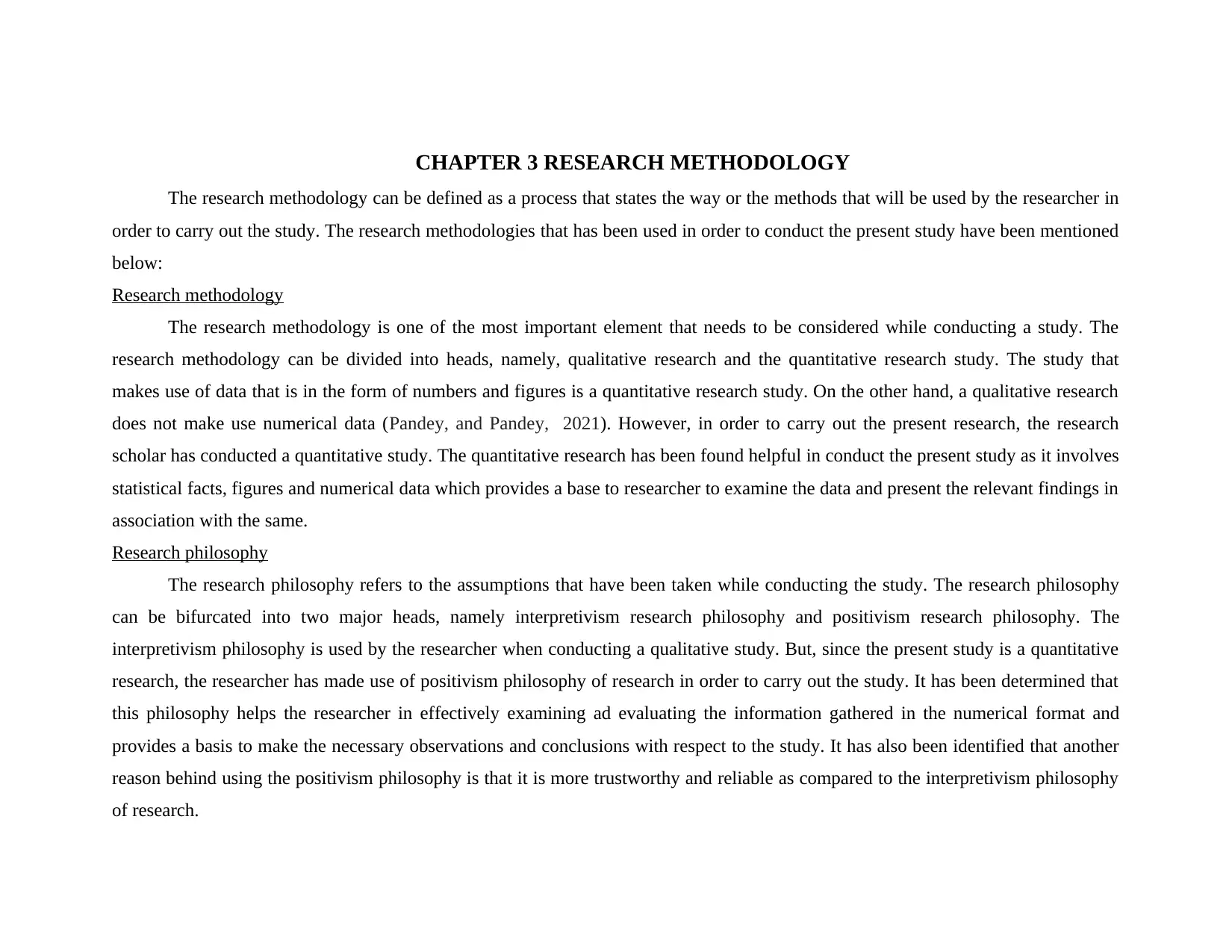
CHAPTER 3 RESEARCH METHODOLOGY
The research methodology can be defined as a process that states the way or the methods that will be used by the researcher in
order to carry out the study. The research methodologies that has been used in order to conduct the present study have been mentioned
below:
Research methodology
The research methodology is one of the most important element that needs to be considered while conducting a study. The
research methodology can be divided into heads, namely, qualitative research and the quantitative research study. The study that
makes use of data that is in the form of numbers and figures is a quantitative research study. On the other hand, a qualitative research
does not make use numerical data (Pandey, and Pandey, 2021). However, in order to carry out the present research, the research
scholar has conducted a quantitative study. The quantitative research has been found helpful in conduct the present study as it involves
statistical facts, figures and numerical data which provides a base to researcher to examine the data and present the relevant findings in
association with the same.
Research philosophy
The research philosophy refers to the assumptions that have been taken while conducting the study. The research philosophy
can be bifurcated into two major heads, namely interpretivism research philosophy and positivism research philosophy. The
interpretivism philosophy is used by the researcher when conducting a qualitative study. But, since the present study is a quantitative
research, the researcher has made use of positivism philosophy of research in order to carry out the study. It has been determined that
this philosophy helps the researcher in effectively examining ad evaluating the information gathered in the numerical format and
provides a basis to make the necessary observations and conclusions with respect to the study. It has also been identified that another
reason behind using the positivism philosophy is that it is more trustworthy and reliable as compared to the interpretivism philosophy
of research.
The research methodology can be defined as a process that states the way or the methods that will be used by the researcher in
order to carry out the study. The research methodologies that has been used in order to conduct the present study have been mentioned
below:
Research methodology
The research methodology is one of the most important element that needs to be considered while conducting a study. The
research methodology can be divided into heads, namely, qualitative research and the quantitative research study. The study that
makes use of data that is in the form of numbers and figures is a quantitative research study. On the other hand, a qualitative research
does not make use numerical data (Pandey, and Pandey, 2021). However, in order to carry out the present research, the research
scholar has conducted a quantitative study. The quantitative research has been found helpful in conduct the present study as it involves
statistical facts, figures and numerical data which provides a base to researcher to examine the data and present the relevant findings in
association with the same.
Research philosophy
The research philosophy refers to the assumptions that have been taken while conducting the study. The research philosophy
can be bifurcated into two major heads, namely interpretivism research philosophy and positivism research philosophy. The
interpretivism philosophy is used by the researcher when conducting a qualitative study. But, since the present study is a quantitative
research, the researcher has made use of positivism philosophy of research in order to carry out the study. It has been determined that
this philosophy helps the researcher in effectively examining ad evaluating the information gathered in the numerical format and
provides a basis to make the necessary observations and conclusions with respect to the study. It has also been identified that another
reason behind using the positivism philosophy is that it is more trustworthy and reliable as compared to the interpretivism philosophy
of research.
⊘ This is a preview!⊘
Do you want full access?
Subscribe today to unlock all pages.

Trusted by 1+ million students worldwide
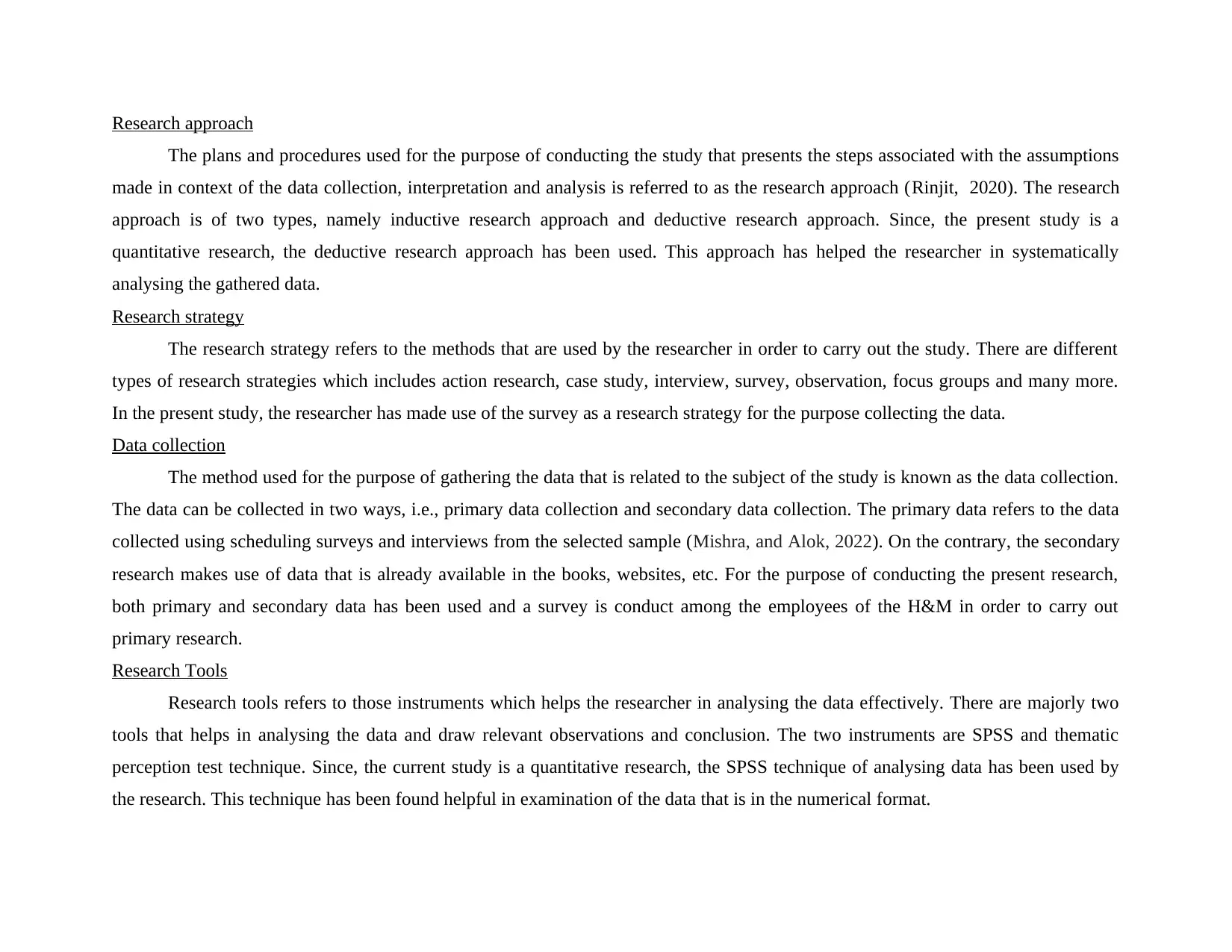
Research approach
The plans and procedures used for the purpose of conducting the study that presents the steps associated with the assumptions
made in context of the data collection, interpretation and analysis is referred to as the research approach (Rinjit, 2020). The research
approach is of two types, namely inductive research approach and deductive research approach. Since, the present study is a
quantitative research, the deductive research approach has been used. This approach has helped the researcher in systematically
analysing the gathered data.
Research strategy
The research strategy refers to the methods that are used by the researcher in order to carry out the study. There are different
types of research strategies which includes action research, case study, interview, survey, observation, focus groups and many more.
In the present study, the researcher has made use of the survey as a research strategy for the purpose collecting the data.
Data collection
The method used for the purpose of gathering the data that is related to the subject of the study is known as the data collection.
The data can be collected in two ways, i.e., primary data collection and secondary data collection. The primary data refers to the data
collected using scheduling surveys and interviews from the selected sample (Mishra, and Alok, 2022). On the contrary, the secondary
research makes use of data that is already available in the books, websites, etc. For the purpose of conducting the present research,
both primary and secondary data has been used and a survey is conduct among the employees of the H&M in order to carry out
primary research.
Research Tools
Research tools refers to those instruments which helps the researcher in analysing the data effectively. There are majorly two
tools that helps in analysing the data and draw relevant observations and conclusion. The two instruments are SPSS and thematic
perception test technique. Since, the current study is a quantitative research, the SPSS technique of analysing data has been used by
the research. This technique has been found helpful in examination of the data that is in the numerical format.
The plans and procedures used for the purpose of conducting the study that presents the steps associated with the assumptions
made in context of the data collection, interpretation and analysis is referred to as the research approach (Rinjit, 2020). The research
approach is of two types, namely inductive research approach and deductive research approach. Since, the present study is a
quantitative research, the deductive research approach has been used. This approach has helped the researcher in systematically
analysing the gathered data.
Research strategy
The research strategy refers to the methods that are used by the researcher in order to carry out the study. There are different
types of research strategies which includes action research, case study, interview, survey, observation, focus groups and many more.
In the present study, the researcher has made use of the survey as a research strategy for the purpose collecting the data.
Data collection
The method used for the purpose of gathering the data that is related to the subject of the study is known as the data collection.
The data can be collected in two ways, i.e., primary data collection and secondary data collection. The primary data refers to the data
collected using scheduling surveys and interviews from the selected sample (Mishra, and Alok, 2022). On the contrary, the secondary
research makes use of data that is already available in the books, websites, etc. For the purpose of conducting the present research,
both primary and secondary data has been used and a survey is conduct among the employees of the H&M in order to carry out
primary research.
Research Tools
Research tools refers to those instruments which helps the researcher in analysing the data effectively. There are majorly two
tools that helps in analysing the data and draw relevant observations and conclusion. The two instruments are SPSS and thematic
perception test technique. Since, the current study is a quantitative research, the SPSS technique of analysing data has been used by
the research. This technique has been found helpful in examination of the data that is in the numerical format.
Paraphrase This Document
Need a fresh take? Get an instant paraphrase of this document with our AI Paraphraser
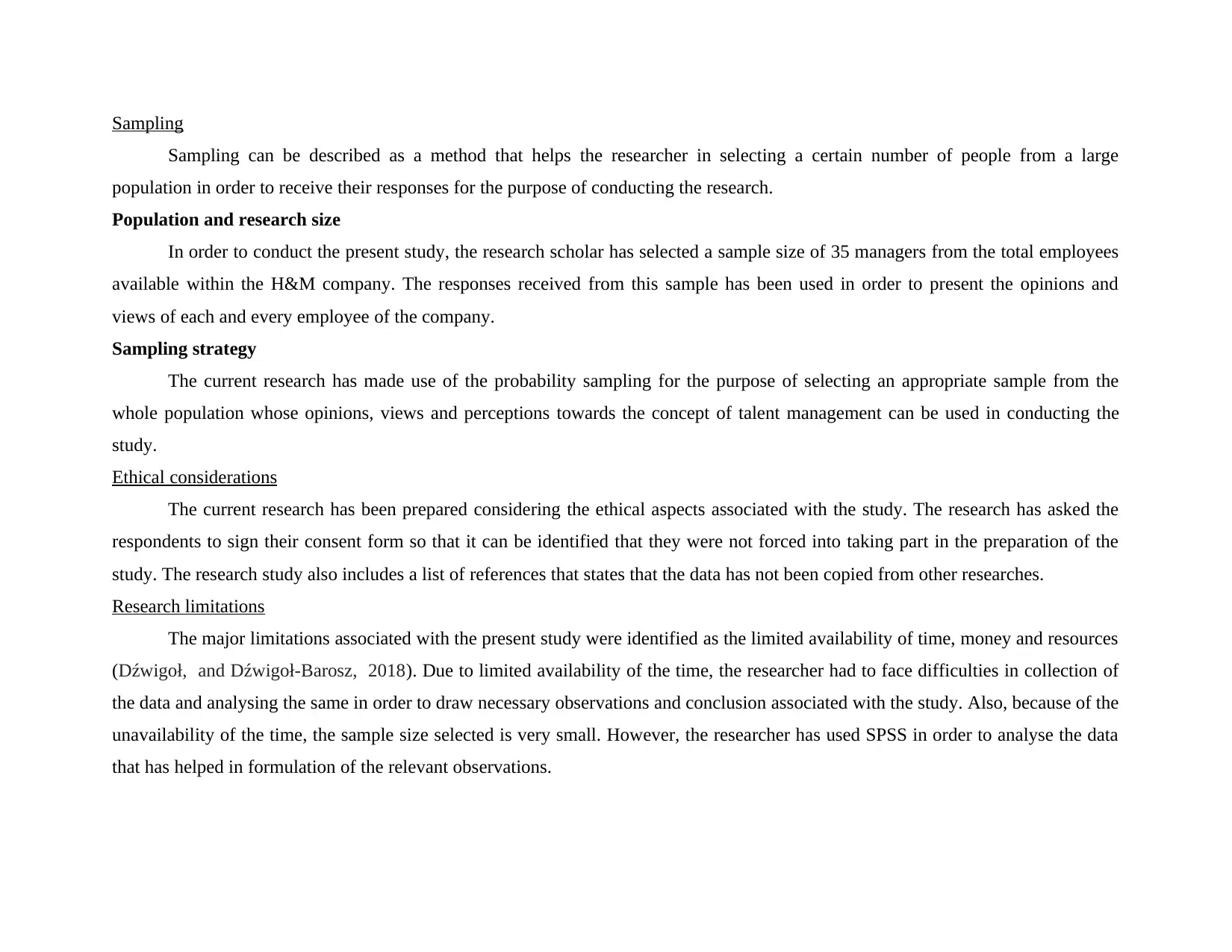
Sampling
Sampling can be described as a method that helps the researcher in selecting a certain number of people from a large
population in order to receive their responses for the purpose of conducting the research.
Population and research size
In order to conduct the present study, the research scholar has selected a sample size of 35 managers from the total employees
available within the H&M company. The responses received from this sample has been used in order to present the opinions and
views of each and every employee of the company.
Sampling strategy
The current research has made use of the probability sampling for the purpose of selecting an appropriate sample from the
whole population whose opinions, views and perceptions towards the concept of talent management can be used in conducting the
study.
Ethical considerations
The current research has been prepared considering the ethical aspects associated with the study. The research has asked the
respondents to sign their consent form so that it can be identified that they were not forced into taking part in the preparation of the
study. The research study also includes a list of references that states that the data has not been copied from other researches.
Research limitations
The major limitations associated with the present study were identified as the limited availability of time, money and resources
(Dźwigoł, and Dźwigoł-Barosz, 2018). Due to limited availability of the time, the researcher had to face difficulties in collection of
the data and analysing the same in order to draw necessary observations and conclusion associated with the study. Also, because of the
unavailability of the time, the sample size selected is very small. However, the researcher has used SPSS in order to analyse the data
that has helped in formulation of the relevant observations.
Sampling can be described as a method that helps the researcher in selecting a certain number of people from a large
population in order to receive their responses for the purpose of conducting the research.
Population and research size
In order to conduct the present study, the research scholar has selected a sample size of 35 managers from the total employees
available within the H&M company. The responses received from this sample has been used in order to present the opinions and
views of each and every employee of the company.
Sampling strategy
The current research has made use of the probability sampling for the purpose of selecting an appropriate sample from the
whole population whose opinions, views and perceptions towards the concept of talent management can be used in conducting the
study.
Ethical considerations
The current research has been prepared considering the ethical aspects associated with the study. The research has asked the
respondents to sign their consent form so that it can be identified that they were not forced into taking part in the preparation of the
study. The research study also includes a list of references that states that the data has not been copied from other researches.
Research limitations
The major limitations associated with the present study were identified as the limited availability of time, money and resources
(Dźwigoł, and Dźwigoł-Barosz, 2018). Due to limited availability of the time, the researcher had to face difficulties in collection of
the data and analysing the same in order to draw necessary observations and conclusion associated with the study. Also, because of the
unavailability of the time, the sample size selected is very small. However, the researcher has used SPSS in order to analyse the data
that has helped in formulation of the relevant observations.
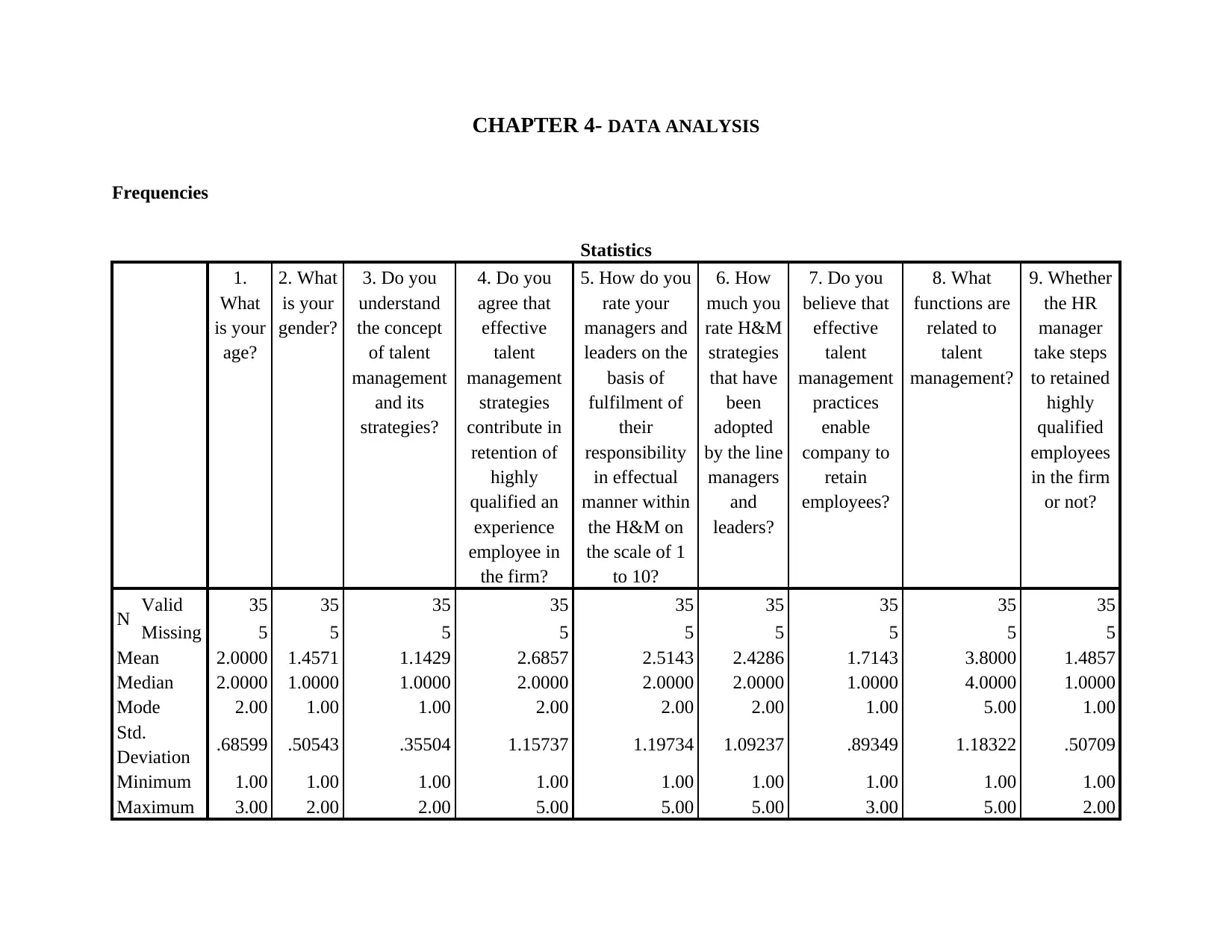
CHAPTER 4- DATA ANALYSIS
Frequencies
Statistics
1.
What
is your
age?
2. What
is your
gender?
3. Do you
understand
the concept
of talent
management
and its
strategies?
4. Do you
agree that
effective
talent
management
strategies
contribute in
retention of
highly
qualified an
experience
employee in
the firm?
5. How do you
rate your
managers and
leaders on the
basis of
fulfilment of
their
responsibility
in effectual
manner within
the H&M on
the scale of 1
to 10?
6. How
much you
rate H&M
strategies
that have
been
adopted
by the line
managers
and
leaders?
7. Do you
believe that
effective
talent
management
practices
enable
company to
retain
employees?
8. What
functions are
related to
talent
management?
9. Whether
the HR
manager
take steps
to retained
highly
qualified
employees
in the firm
or not?
N Valid 35 35 35 35 35 35 35 35 35
Missing 5 5 5 5 5 5 5 5 5
Mean 2.0000 1.4571 1.1429 2.6857 2.5143 2.4286 1.7143 3.8000 1.4857
Median 2.0000 1.0000 1.0000 2.0000 2.0000 2.0000 1.0000 4.0000 1.0000
Mode 2.00 1.00 1.00 2.00 2.00 2.00 1.00 5.00 1.00
Std.
Deviation .68599 .50543 .35504 1.15737 1.19734 1.09237 .89349 1.18322 .50709
Minimum 1.00 1.00 1.00 1.00 1.00 1.00 1.00 1.00 1.00
Maximum 3.00 2.00 2.00 5.00 5.00 5.00 3.00 5.00 2.00
Frequencies
Statistics
1.
What
is your
age?
2. What
is your
gender?
3. Do you
understand
the concept
of talent
management
and its
strategies?
4. Do you
agree that
effective
talent
management
strategies
contribute in
retention of
highly
qualified an
experience
employee in
the firm?
5. How do you
rate your
managers and
leaders on the
basis of
fulfilment of
their
responsibility
in effectual
manner within
the H&M on
the scale of 1
to 10?
6. How
much you
rate H&M
strategies
that have
been
adopted
by the line
managers
and
leaders?
7. Do you
believe that
effective
talent
management
practices
enable
company to
retain
employees?
8. What
functions are
related to
talent
management?
9. Whether
the HR
manager
take steps
to retained
highly
qualified
employees
in the firm
or not?
N Valid 35 35 35 35 35 35 35 35 35
Missing 5 5 5 5 5 5 5 5 5
Mean 2.0000 1.4571 1.1429 2.6857 2.5143 2.4286 1.7143 3.8000 1.4857
Median 2.0000 1.0000 1.0000 2.0000 2.0000 2.0000 1.0000 4.0000 1.0000
Mode 2.00 1.00 1.00 2.00 2.00 2.00 1.00 5.00 1.00
Std.
Deviation .68599 .50543 .35504 1.15737 1.19734 1.09237 .89349 1.18322 .50709
Minimum 1.00 1.00 1.00 1.00 1.00 1.00 1.00 1.00 1.00
Maximum 3.00 2.00 2.00 5.00 5.00 5.00 3.00 5.00 2.00
⊘ This is a preview!⊘
Do you want full access?
Subscribe today to unlock all pages.

Trusted by 1+ million students worldwide
1 out of 38
Related Documents
Your All-in-One AI-Powered Toolkit for Academic Success.
+13062052269
info@desklib.com
Available 24*7 on WhatsApp / Email
![[object Object]](/_next/static/media/star-bottom.7253800d.svg)
Unlock your academic potential
Copyright © 2020–2025 A2Z Services. All Rights Reserved. Developed and managed by ZUCOL.




